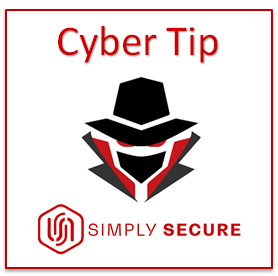
Have You Made Yourself a Target?
Have you heard the statement, “It won’t happen to me”, then it happened! We are all at risk and the stakes are high – to your personal and financial well-being.
- Network security is everyone’s responsibility, not just the CIO.
- You must remain vigilant and aware of your virtual and physical surroundings.
- Every incremental security step taken reduces your risk significantly, you’re not over-doing it!
- Security is always expensive until it’s not enough.
- Smaller businesses are prime targets due to their lack of security controls, take the necessary steps to protect your business.
Tip #1 – Keep software updated:
Installing software updates for your operating system and programs is critical, always install the latest security updates for your devices. Vulnerabilities are known risks that could be used to exploit a software and one sure way to minimize these types of attacks are pro-active software updates. In one day, WannaCry infected more than 230,000 computers in 150 countries with approximately $4 billion in financial losses.
These simple steps could significantly reduce your risks
- Always install the latest security updates for all your devices!
- Turn on Automatic updates within your operating system.
- Use web browsers (Chrome, Firefox) that receives frequent automatic security updates.
- Make sure to keep a security browser plug-in
Tip #2 – Beware of suspicious emails and phone calls – Avoid Phishing!
Phishing scams are a constant threat, cyber-criminals will attempt to trick you into divulging critical information like your login ID, password, banking or credit card information.
Tip #3 – Practice good password management
We all have too many passwords to manage – and it’s easy to take short-cuts, like reusing the same password. A password management program can help you to maintain strong unique passwords for all of your accounts. These programs can generate strong passwords for you, enter credentials automatically, and remind you to update your passwords periodically.
- Use long passwords, 16 characters or more.
- Use a strong mix of characters, and never use the same password for multiple sites.
- Don’t share your passwords and don’t write them down.
- Update your passwords periodically.
Tip #4 – Be careful what you click
Avoid visiting unknown websites or downloading software from untrusted sources. If attachments or links in the email are unexpected or suspicious for any reason, don’t click on it!
Tip #5 – Never leave devices unattended
The physical security of your devices is just as important as their technical security.
- If you need to leave your laptop, phone, or tablet for any length of time – lock it up so no one else can use it.
- If you keep sensitive information on a flash drive or external hard drive, make sure to keep these locked as well.
- For desktop computers, shut-down the system when not in use – or lock your screen.
Tip #6 – Protect sensitive data
Be aware of sensitive data that you come into contact with, and associated restrictions – review the UCB Data Classification Standard to understand data protection level requirements. In general:
- Keep sensitive data (e.g. SSN, credit card information, staff records, health information, etc.) off of your workstation, laptop, or mobile devices.
- Securely remove sensitive data files from your system when they are no longer needed.
- Always use encryption when storing or transmitting sensitive data.
Unsure of how to store or handle sensitive data? Contact us and ask!
Tip #7 – Use mobile devices safely
Considering how much we rely on our mobile devices, and how susceptible they are to attack, you’ll want to make sure you are protected:
- Lock your device with a PIN or password – and never leave it unprotected in public.
- Only install apps from trusted sources.
- Keep your device’s operating system updated.
- Don’t click on links or attachments from unsolicited emails or texts.
- Avoid transmitting or storing personal information on the device.
- Most handheld devices are capable of employing data encryption – consult your device’s documentation for available options.
- Backup your data.
Tip #8 – Install anti-virus protection
Only install an anti-virus program from a known and trusted source. Keep virus definitions, engines and software up to date to ensure your anti-virus program remains effective.
Tip #9 – Back up your data
Back up regularly – if you are a victim of a security incident, you’ll be happy you did.

